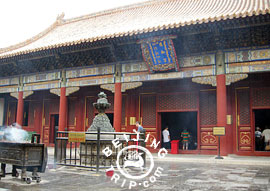
When you say grand and biggest preserved lamasery in China, the Lama Temple or Yonghe Lamasery comes to mind. This temple is in North Beijing, known as the place of peace and harmony. With its magnificent big halls and fancy archways that serve as home to Buddhist arts, it is a tribute to China’s rich culture.
The temple, built in the 16th century during Qing Dynasty was intended to serve as the residence of Emperor Yongzheng. In the 17th century however, it was changed to Yonghe lamasery housing sculptures of Buddhist gods, Buddhas, and demons. The temple is one reason why the Great Wall’s construction was not completed during the Qing Dynasty as it housed monks from Tibet and Mongolia.
Yellow tiles were used for the flooring of the Lama temple, the same with the Hall of Harmony and Peace. Hall of Harmony and Peace has 3 bronze Buddha statues: Gautama Buddha, Kasyapa Buddha, and Maitreya Buddha.
The other hall is the Hall of Everlasting Protection where a Bhaisaya guru Buddha is placed as a center attraction.
The Hall of the Wheel of the Law is a venue for reading and religious ceremonies. The Je Tsongkhapa statue is found here along with the Five-Hundred-Arhat-Hill made of the metals tin, gold, silver, iron, and copper.
The Hall of Heavenly Kings houses a Maitreya Buddha statue, and the wall sculptures of the four Heavenly Kings.
The last hall, the Pavilion of Ten Thousand Happiness, has an 18 meter tall Maitreya Buddha Sandalwood sculpture.
It is not difficult to find this temple. The Lama Temple is one of the most popular and most important buildings of Chinese culture. The courtyards and the halls, with its intricate decorations and spacious areas are so majestic.

Lama Temple

No comments:
Post a Comment
Feel free to place you thoughts here